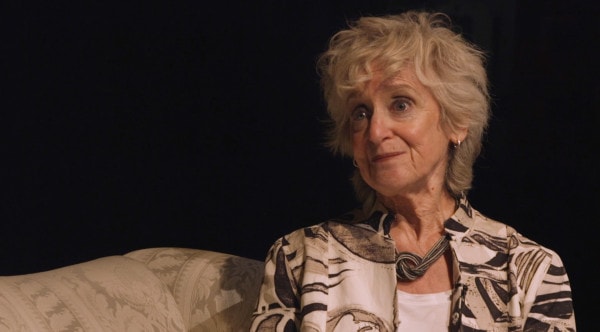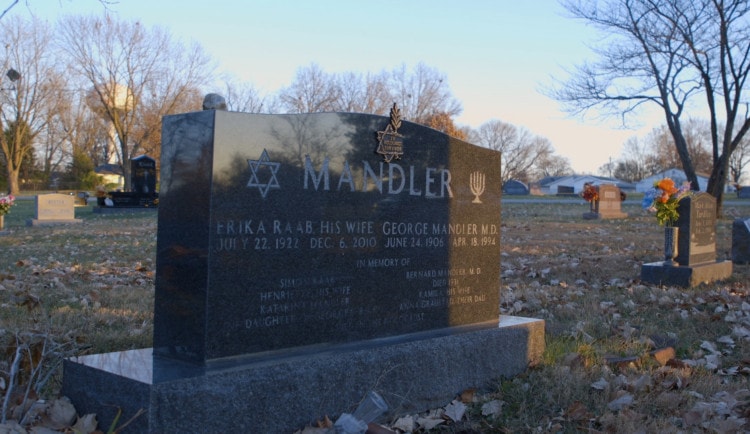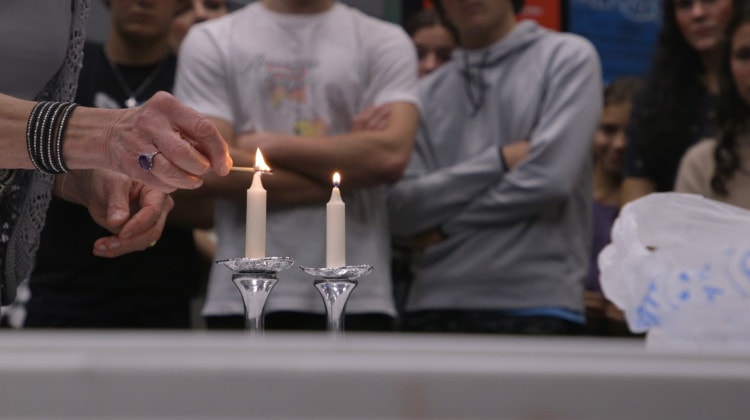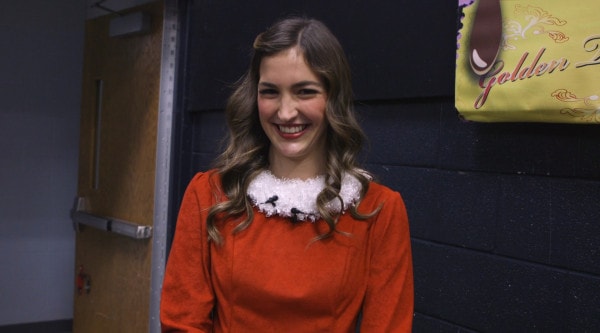Chillicothe Remembers the Holocaust Through the Lives of its Survivors Play Preserves Memories of the Mandler Family
Published November 23rd, 2022 at 6:00 AM
Above image credit: Camilla Mandler lit her Shabbat candles before opening night of the play. She thanked the cast for their mitzvah honoring her parents. (Cami Koons | Flatland)A small stone sits atop the granite monument, the one that honors the Mandler family in a Chillicothe, Missouri, cemetery.
It’s a Jewish tradition, placing a stone or pebble, signifying a visitor’s intent to preserve memories of those who have passed.
Eight Mandler family members are memorialized there, some were killed as part of the Nazi Holocaust, some survived. One died right before Adolf Hitler became chancellor of Germany.
An area high school student might have left the stone, said Lisa Rule, who works in Chillicothe High School’s English and Drama departments.
Her students sometimes visit the Mandler gravesite.
Rule is the impetus for hundreds of Chillicothe high schoolers’ commitment to the story of George and Erika Mandler and their relatives who died during World War II, including an infant daughter who was only 2 days old.
Flatland on YouTube
A teacher, Rule wrote a play about George and Erika – a couple who survived the Holocaust only to find antisemitism in the United States upon immigrating.
In the late 1940s, New York was teeming with displaced people after the war. And elsewhere, in Pennsylvania, the couple was told they weren’t wanted there.
It was devastating. They’d already endured so much.
Eventually, Dr. George Mandler began looking to the West. He answered an advertisement in a medical journal seeking a physician for a small Midwest town.
“He responded to the ad, and his first sentence was, ‘I’m a Jew, and my wife is a Jew,’ ” said Camilla Mandler, the couple’s only daughter. “And the response was, ‘If you want us, we want you.’ ”
The town that wanted them was Chillicothe.
The correspondence was the beginning of the family’s Midwestern life, where they would live until their deaths. George died in 1994, at 87, followed by his wife in 2010, at 88.

Camilla was born in Chillicothe, a town she still considers “home,” despite spending years in Europe and now being settled in Santa Fe, New Mexico.
The Mandler’s story is unusual even among Holocaust survivors.
Erika’s first husband died at Auschwitz. They’d been married less than a year.
She met George Mandler when her family was sent to Nováky, a concentration camp in Slovakia, a wartime client state of Germany. They quickly fell in love.
George Mandler was a doctor in the camp and part of the Jewish resistance. He’d already escaped incarceration once by digging out of his cell with a spoon.
By Aug. 6, 1944, the Germans had marched closer to the Czech border and the Slovak guards didn’t think they could hold the Jews any longer, according to a testimony given later by Erika Mandler. “So they just opened the gates and so to speak told us: ‘You are free. Go but you are on your own — whatever you can do.’ ”
Her husband helped with the resistance and tried to secure the safety of her parents. But eventually, the couple would flee into the mountains with the German SS closing in.
Their life during wartime was in stark contrast with the peaceful life they established in America’s rural Midwest.
Chillicothe is a town with no synagogue and no current Jewish population. In fact, the Jewish section of the cemetery where the Mandlers are buried is populated by people who died not only before World War II, but before the Civil War.
Once, Chillicothe had a bustling Jewish community. Many were merchants and several of the town’s buildings bear names like those in the cemetery. Wallbrunn, for one.

By the time Camilla Mandler was born, there were no other Jewish families there.
She attended the most recent production of Rule’s play in November, watching high schoolers perform her family’s story: “Courage and Love: The George & Erika Mandler Story.”
This was the school’s second production of the play. The first performance was in 2008 when Erika Mandler was still alive and able to participate as a special guest.
The timing for reviving the play seemed right to all involved, given the recent surge in antisemitism globally and recent incidents within the United States.
But that also meant that security was of a concern. Local law enforcement attended every school rehearsal and patrons passed through security screens as they entered the Friday and Saturday night performances.
“I think it’s a sad commentary on our society now that we have to think about those things,” Rule said. “But I think it would be foolish not to.”
’Dogs And Jews Are Not Permitted’
Teenagers cluster in groups backstage at Chillicothe High School’s performing arts center.
They’re folding playbills for their evening performance, set to start within the hour.
The cast is large.
About 50 students are cast as Nazi guards, inmates in the camps, Hitler youth, rebel fighters and, of course, the central characters of George, Erika, their parents and siblings.
Everyone is already in costume.
Camilla Mandler enters. The students stop their work, huddling around her in a semi-circle.
She shows them the ring on her hand, the purple of the amethyst stone. It’s the ring that her grandparents had left for her mother.
The heirloom also survived the Holocaust.
She praised the students, telling them that they were courageous for telling the truth.

“Knowing truth is being aware of what happened in the past,” she said. “And that is what will keep it from happening in the future.”
And then she began to explain that their performance is a mitzvah.
“You’re giving voice to the millions of people who lost their voices, you are giving them voice,” she said. “So that is called a mitzvah. And the mitzvah is not an obligation, or it’s not a duty, but a mitzvah is a commandment.”
It’s Friday, the beginning of the Jewish Sabbath. So next, she lit the Shabbat candles that she’d brought from her home and offered a blessing.
“You are all doing an incredible mitzvah by doing this, and my parents, thank you,” she said. “Keeping the family’s story alive is a mitzvah.”
Juliann Gabrielson is a senior cast in a lead role, as Erika Mandler.
She has vague memories of the real Erika. She was the older lady who lived next door to her parents when she was a toddler.
Mandler would give the little girl caramel candies and they’d sit on the front stoop together.
“I knew that she was Jewish,” Juliann said. “And I think I knew that she was a Holocaust survivor, but I never really knew much more than just the basics.”

That was until Juliann read the book about Erika and George Mandler.
“In middle school is when I read the book and really learned that I had a miracle right next door.”
In one early scene of the play, Juliann portrays Erika with her girlfriends, giggly and giddy.
Erika Raab Mandler’s parents were Orthodox Jews living in Austria. Before the war, they had been very open to allowing their children to socialize with people of other faiths. Erika went to Christmas Eve mass with her girlfriends’ families and helped decorate the Christmas tree.
As Hitler consolidated power, everything changed.
Her friends crossed the street to avoid her.
The park, where the girls had all skated together, soon posted a sign: “Dogs And Jews Are Not Permitted.”
There’s a cadence to the play. Jovial family life is increasingly interrupted by war, hate and genocide. First relatives in Berlin fled, then the family had to leave their home in Austria for Czechoslovakia.
One of the most violent scenes involves no gunshots, but rather a negotiation.
Camp Nováky, which was guarded by Slovaks, was more humane than the other camps. Families were allowed to live together, they didn’t separate men from women.
Still, orders began to come to load a cattle car with 300 Jews to be delivered to another camp where the genocide was being carried out.
One day, the names called out were “Simon Raab, Henrietta Raab, Kurt Raab, Erika.”
George Mandler used his influence as a camp doctor, saying that he would go too if Erika was sent off.
She was spared. And then Erika begged for her parents and brother to be saved. The guards relented.
But the order was for a boxcar filled with exactly 300 Jews. So four more names were called. And those four are depicted being pulled and thrown screaming in protest onto the train before it pulls away, headed to Auschwitz.
Students have told Rule that after their performances and rehearsal, they find a quiet place to sit and cry.

The emotion comes with the realization that they’ve depicted a real person who was put to death solely because they were Jewish.
Some scenes are more symbolic, such as when the couple crossed the Ďumbier mountain in Slovakia to reach the eastern side of Czechoslovakia, which had been liberated by Soviet troops.
The snow was up to Erika’s waist. She had two sweaters, no gloves and was seven months pregnant. Once across, their daughter Katarina was born. But she survived only days.
Each act opens with a video vignette of the real Erika Mandler telling part of her story.
Testimony of survivors of the Holocaust has been carefully compiled by several organizations globally, including Overland Park’s Midwest Center for Holocaust Education.
Erika Mandler provided a three-hour testimony in 1996 for the USC Shoah Foundation Institute Visual History Archive.
Remembering the Holocaust
But George Mandler did not.
In fact, he didn’t speak much of his experiences, something that his daughter sees as just one aspect of what was likely post-traumatic stress disorder.
When George Mandler died, the rabbi who came from St. Joseph commented that he was blessed to be able to conduct the services, said Dr. Bruce Brodmerkle, an optometrist who knew Mandler for about a decade before his death.
George Mandler, the rabbi noted, would have been among the last of the Holocaust survivors who had been a doctor in one of the camps.
To many in town, he was the man with the clipped Germanic accent, which caused some to assume that he was gruff. In reality, he “had a heart of gold and was soft as butter,” Brodmerkle said.
“Anyone that knew him thought he was just the best person to ever meet,” he said.
Mandler was also known for his brilliance.
Among the last memories that Brodmerkle has of his friend, came when he visited Mandler and found him studying, “brushing up on his French.”
’The Big Town Where We Live’
The name Chillicothe is taken from the Shawnee Indians, the area’s original inhabitants. It means “the big town where we live” or “our big home.”
A majestic statue of a Shawnee native stands in the town square.
Nowadays, most might know the town as the home of sliced bread. Sliced bread was first offered for sale there in 1928 as a product of the Chillicothe Baking Co., sliced on a machine called the Rohwedder Bread Slicer.
Rule is invested in preserving the history of her community. Her other two plays chronicled many of the important figures buried in its cemeteries.
But like many of her current charges, Rule’s childhood in Chillicothe didn’t expose her to anyone Jewish.
That changed when she entered college at Oral Roberts University.
Her freshman roommate was a Messianic Jew, which is someone of Jewish heritage who identifies as Jewish, while also acknowledging Jesus as the Messiah.
Rule gained a respect and affinity for many aspects of Judaism through that early friendship.
When she married her husband while still in college, they conducted the ceremony under a huppah, a type of canopy, and he shattered a glass during the ceremony, also a tradition steeped with meaning.
Her initial career plan was to enter journalism.
But teaching soon became her passion. She’d long taught “The Diary of Anne Frank” and it was during that time that her mother suggested that she met Erika Mandler, whose husband had already passed.
Soon, Erika began speaking to her students.
Writing the play became the next step.
Now, Rule has added a special lesson on the Holocaust that she gives to students before they begin reading “Night,” by Elie Wiesel, the 1960 memoir that recounts his experiences, along with his father, in the Auschwitz and Buchenwald concentration camps.
Honoring the Dead


One projection estimated that there would be about 67,000 survivors of the Nazi Holocaust alive in the United States by 2020. All are over 75 years old and nearly 60% are at least 85.
Their ability to speak for themselves diminishes as more pass on.
And Holocaust deniers have started to fill the void.
It’s one reason that in addition to two public performances, the Chillicothe High School Players also performed the story for students.
All told, 1,100 students saw it this fall. And another 1,200 people attended the public shows.
Next spring, Rule’s students will move on to a different type of production. They will perform Disney’s animated smash hit “Frozen; The Broadway Musical,” having been chosen as the only high school in the state of Missouri that will be allowed to do so.
But the lessons of this semester have been shared.
“Even in small towns, we care about fighting antisemitism,” Rule said.
The teenagers that she teaches are well aware of recent incidents. They know about celebrities and sports stars posting antisemitic messaging. They come to her, repeatedly, wanting to talk about each incident.
“Teenagers are invested in fighting antisemitism. They see it on social media,” she said. “I know that all of my cast now would be really vocal if they saw something.”
More on Kansas City PBS
Mary Sanchez is senior reporter for Kansas City PBS. Cami Koons covers rural affairs for Kansas City PBS in cooperation with Report for America. The work of our Report for America corps members is made possible, in part, through the generous support of the Ewing Marion Kauffman Foundation.



